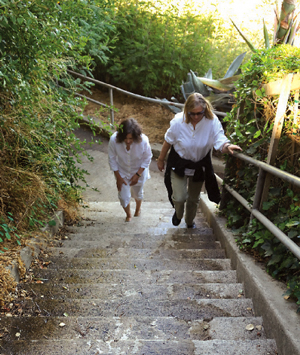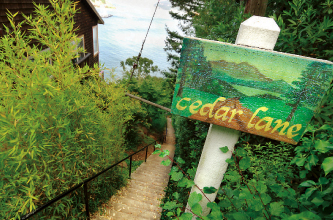I’m walking in the Sausalito hills, looking for a stairway tucked into the cul-de-sac end of Prospect Avenue. The summer fog is already in, the air is thick with eucalyptus and the growing sound of traffic spilling over from the freeway above means I’m close to my destination.
All afternoon this is what I’ve been doing, lugging myself and 30 pounds of camera gear up and down. The problem is I don’t see the stairs. There’s nothing at the end of the street except what appears to be a wall of bramble climbing up to Highway 101. At the last house on the street a man and a woman stand talking in a driveway. He’s taking a break from yard work. She is dressed in red, the same color as her hair. I ask about the stairs. The woman answers. “If you like stairs,” she says, a wide smile framing her words, “then your dream is just ahead.”
Despite the glowing burn in my calves, the steady twitch in my quads and the nagging realization that my aging knees may refuse to ambulate in the morning, I laugh. The line between dream and nightmare is whisper thin and I have a feeling I’m about to cross it. Fifty feet farther down the road, there they are—seven concrete flights, daunting, but not nearly as steep as some I’ve already climbed on my trek up from the waterfront on Bridgeway.
A few minutes and some heavy breathing later, I’m on the Spencer Avenue overpass, looking down at the freeway. I feel self-congratulatory, not so much for the physical climb—although it is indeed a grind—but more for overcoming the habit of using four wheels to take me somewhere where two legs will work just as well.
As you’ll see, the story of the dozens of hidden and not-so hidden public stairways in Marin is really a tale about getting from point A to point B the old-fashioned way—on foot—and what you might find as you go.
A BIT OF HISTORY
The hilly cities of southern Marin, from Sausalito to Corte Madera, are dotted with public steps and stairways linking one neighborhood to another. Finding a definitive number of these stairways is elusive. Many are mapped. A few aren’t. Many have names, historic markers or signposts. Others seem abandoned. 
Some accounting has been done, though. A recent effort by Mill Valley to inventory all its steps, paths and lanes found more than 175 such byways, not all of them stairs, but most involving some sort of hill. In Sausalito, local writer Dorothy Gibson detailed the history of more than two dozen stairways and painstakingly counted the steps in each—109, for example, on El Monte, which leads up from Bridgeway to Bulkley Avenue. In Belvedere, a map (obtainable from city hall) shows how to find the city’s 18 stair-stepped lanes, each marked by a colorful illustrated sign.
The first impression many of these stairways present is age—and old they are. Some date back to the 1890s and many others to the early 1900s, remnants of the first days of these cities when cars were still a rarity, electric trains linked Fairfax, San Anselmo, Mill Valley and San Rafael with Sausalito, and the common connection to San Francisco for a commuter or a weekend homeowner was the ferry.
The stairways were built essentially as shortcuts from the hill neighborhoods to the flats, where the trains or the ferry terminals were. Developers constructed some as enticements for would-be home buyers. Other paths evolved organically as residents (or servants) eschewed the looping switchbacks of hillside roads in favor of more direct routes.
The vintage is readily visible. Art Deco–esque pillars bracket the lower entrance of the North Street steps in Sausalito. In Mill Valley, broken slabs of concrete and loose wooden railings make for treacherous passage on the steep Willow Steps above Miller Avenue, and a crumbly dirt path, rippled with tree roots, substitutes for stairs on Alcatraz Lane.
Although the years have left many stairways in disrepair, they have also forged character and ambience. Most of the steps ascend and descend through lush bowers of mature bay, oak and eucalyptus. Gardens from adjoining yards spill onto a path, brightening the way with seasonal blooms. On a warm day, the stairways are shaded and cool; when it’s foggy, they darken further into mysterious tunnels with a light that beckons from the streets at either end.
WORK AND A WORKOUT
Today, the stairs serve many purposes. Some people still find them utilitarian. Any weekday morning in Sausalito the broad stairway of Excelsior Lane across from Plaza Viña del Mar sees steady foot traffic from pedestrians bound for San Francisco by ferry or Golden Gate Transit buses.
For others, the stairs are recreational, a means to escalade their way to exercise and burn calories—fighting gravity one step at a time. The Arch Street stairway in Larkspur becomes an outdoor gym on weekends. Personal trainers and their clients join other hard-core types to share the pain produced by trudging up and down the steps, some making the round trip 30 or 40 times.
Some routes include a respite. The second section of the Cable Roadway in Sausalito begins with a flat dirt path and a humble bench, acknowledgment that the first leg, from North Street to Crescent Avenue, is a steep-stepped quad-burner. The North Street stairs are interrupted halfway up from Bridgeway with a broad concrete bench set into a garden grotto that offers views of San Francisco and an impressively large agave plant. The bench is dedicated to Suzanne Renee Leider, a cancer activist who died in 2002; a plaque reads, “More precious was the light in your eyes than all the roses in the world.”
A WAY TO GO GREEN
Of the Marin cities, Mill Valley seems the most ambitious about convincing residents that its stairways can be used for more than just the annual running of the various Dipsea races, named for the city’s most famous set of stairs, which run in three levels from Old Mill Park to Edgewood Avenue. “The city has made it a priority to renovate the stairs,” says Christine Sansom, city Parks and Rec director.
Driven by both environmental motivations—more walkers, fewer cars—and public safety concerns—stairs provide an escape route in an earthquake or fire—the city has set aside $100,000 each of the last two years to fix up the stairs. Already done is Miller Lane, connecting the Depot Plaza area with Ethel Avenue; in the works are the Willow Steps and Marion Lane, between Cascade Drive and Marion Avenue.
 Victoria Talkington, a former city planning commissioner, pushed for the renovations, along with creation of a useful detailed city map (available at the library) that shows all of Mill Valley’s stairways and pathways. Her main intentions were green: “Marin County has an average of 11 automobile trips per household per day, most of them within a quarter to a half mile of the house,” she says. “A very easy way to reduce traffic congestion is to get people walking on routes right near their houses.” The stairways are a “cheap and direct way of getting places that doesn’t use fossil fuel.”
Victoria Talkington, a former city planning commissioner, pushed for the renovations, along with creation of a useful detailed city map (available at the library) that shows all of Mill Valley’s stairways and pathways. Her main intentions were green: “Marin County has an average of 11 automobile trips per household per day, most of them within a quarter to a half mile of the house,” she says. “A very easy way to reduce traffic congestion is to get people walking on routes right near their houses.” The stairways are a “cheap and direct way of getting places that doesn’t use fossil fuel.”
They also send children a positive message about traveling on foot. “With Mill Valley’s changing demographics of more young families, [using the stairs] is a way to educate kids that daily physical activity can be part of their lives.”
AND IT’S FUN
Marin’s stairways take you places—but slowly. There’s plenty of time to observe what appears along the way and to greet fellow travelers.
On the Bernard Steps in Mill Valley one evening, I meet a delightful couple en route to a film festival screening from their home up the hill. He looks familiar, but I can’t place the face. They say they’re step-climbing regulars. “I love it when we can do errands on foot,” says the woman, talking as we walk down Bernard Street. “I feel European.”
I ask their names and as I scribble in my notebook and they stride onward, recognition comes. He’s Jim Lange, broadcaster and longtime host of The Dating Game; she’s his wife, Nancy, a former Miss America.
The steps are full of surprises. Some lie behind bordering fences, such as gardens—hidden from the street but open to those taking the backstage tour. Others face outward, such as signs clearly intended to amuse or influence those passing by—Thank You for Speaking Softly (on the Dipsea steps), The Road to Enlightenment (Alcatraz Lane) and my favorite: Live Well, Laugh Often, Love Much (Bernard steps).
There’s more: lovely gates, hand-carved name tags for houses (Casa Isabella, El Monte Lane, Sausalito), gnomes, a ceramic frog, toys hung in trees, Christmas lights lit all year round.
It’s all there on the steps of Marin—yours just for the walking.


